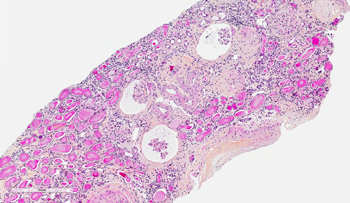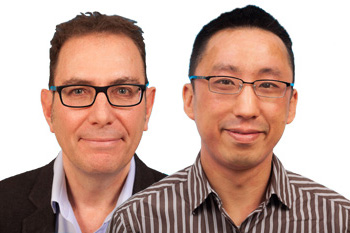‘From bedside to bench to bedside’: basic science research and collaboration leads to company that will fight fibrosis

By Ana Gajic

This is what kidney fibrosis looks like under the microscope – a disease Fibrocor is fighting. (Photo courtesy of Dr. Adriana Krizova, a pathologist at St. Michael’s)
As many scientists in the Keenan Research Centre for Biomedical Science (KRCBS) will tell you, taking an idea from a need in the hospital, bringing it to the lab to study, and then using that new knowledge to transform patient care is one of the main goals of discovery science, and it often takes years to achieve.
One team at the KRCBS is close to reaching this goal, thanks to a grant from the Banting and Best Diabetes Centre that allowed them to launch a company from research done at St. Michael’s and Mount Sinai Health System.
Dr. Richard Gilbert and Dr. Darren Yuen, clinician-scientists at the hospital’s KRCBS, along with Dr. Jeff Wrana at Sinai, were awarded a grant in 2015 to find the molecular drivers of fibrosis – or excessive scarring – from human biopsy tissue. This grant, along with support from MaRS Innovation, led to the development of Fibrocor Therapeutics – a company dedicated to targeting fibrosis, the science behind which began at St. Michael’s.
“Excessive scar tissue, or fibrosis, is the foundation of many types of disease,” said Dr. Gilbert. “It’s the major factor that drives most forms of diseases in the kidney, liver, lung, and heart. It’s also behind the restricted movement in arthritis. Though it’s an important target, there are almost no drugs for it.”
Historically, scientists have focused on cells in petri dishes or other lab models of kidney disease to research fibrosis.
“This has made us really good at treating that kind of damage in cells, but we’re not good at treating the disease in humans yet,” said Dr. Yuen. “The thought was, let’s go to where the disease actually is.”
With the help of the Pathology Department at St. Michael’s and after approval from the St. Michael’s Hospital Human Research Ethics Committee, the team was able to investigate the molecular makeup of the kidney biopsies.

Drs. Richard Gilbert (left) and Darren Yuen
In many institutions, Dr. Yuen said, it can be difficult to access human tissue. But for the Pathology team at St. Michael’s, collaboration is at the core of progress, said Dr. Adriana Krizova, a pathologist at St. Michael’s. She worked with Dr. Yuen and Dr. Gilbert to provide them with tissue needed for their work.
“Without research, we won’t find anything new,” she said. “There will be no new medications, there will be no cure. Nothing is going to happen unless we get involved. It’s amazing that our work can be helpful to fibrosis beyond just providing a diagnosis to one patient at a time.”
This partnership with the Pathology team “is the crux of our success so far,” Dr. Gilbert said. With the help of Dr. Krizova and the Department of Pathology, KRCBS researchers were able to identify the molecular drivers of fibrosis. They then partnered with a drug development company called Evotec to develop new drugs that block those drivers.
“This way, we can go right from the bedside – the biopsy material – through to the bench to develop new drugs, and then back to the patient bedside to deliver the drugs,” Dr. Gilbert said.
This collaboration between academic health researchers, hospital physicians, and business experts has made this into a unique enterprise. According to Dr. Gilbert, it has also expedited drug development that may have an impact on millions of patients around the world.
“I don’t think that a lot of other institutes, simply because of their set-up, could have created the same type of collaboration,” Dr. Yuen said, alluding to the collaborative environment at St. Michael’s and the strong connection between the hospital and research. “When you’re so close to the hospital and you have people that populate both sides, it drives innovation that actually matters to patients.”
Fibrocor’s first asset is still at its early stages, and the company recently announced a partnership with Galapagos NV, a pharmaceutical research company, to bring it closer to testing.
In the meantime, outside of Fibrocor, Dr. Yuen, Dr. Gilbert, Dr. Krizova and their teams will continue to research other targets to fight fibrosis. For all of them, the patients are at the centre of their research goals.
“Unless we’re doing something that we know is going to directly contribute to patients down the road, it doesn’t seem exciting to us,” Dr. Gilbert said. “The patients are everything.”
About St. Michael’s Hospital
St. Michael’s Hospital provides compassionate care to all who enter its doors. The hospital also provides outstanding medical education to future health care professionals in more than 29 academic disciplines. Critical care and trauma, heart disease, neurosurgery, diabetes, cancer care, care of the homeless and global health are among the Hospital’s recognized areas of expertise. Through the Keenan Research Centre and the Li Ka Shing International Healthcare Education Centre, which make up the Li Ka Shing Knowledge Institute, research and education at St. Michael’s Hospital are recognized and make an impact around the world. Founded in 1892, the hospital is fully affiliated with the University of Toronto.
About Unity Health Toronto
Unity Health Toronto, comprised of Providence Healthcare, St. Joseph’s Health Centre and St. Michael’s Hospital, works to advance the health of everyone in our urban communities and beyond. Our health network serves patients, residents and clients across the full spectrum of care, spanning primary care, secondary community care, tertiary and quaternary care services to post-acute through rehabilitation, palliative care and long-term care, while investing in world-class research and education. For more information, visit www.unityhealth.to.
